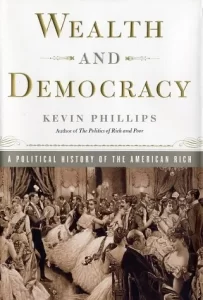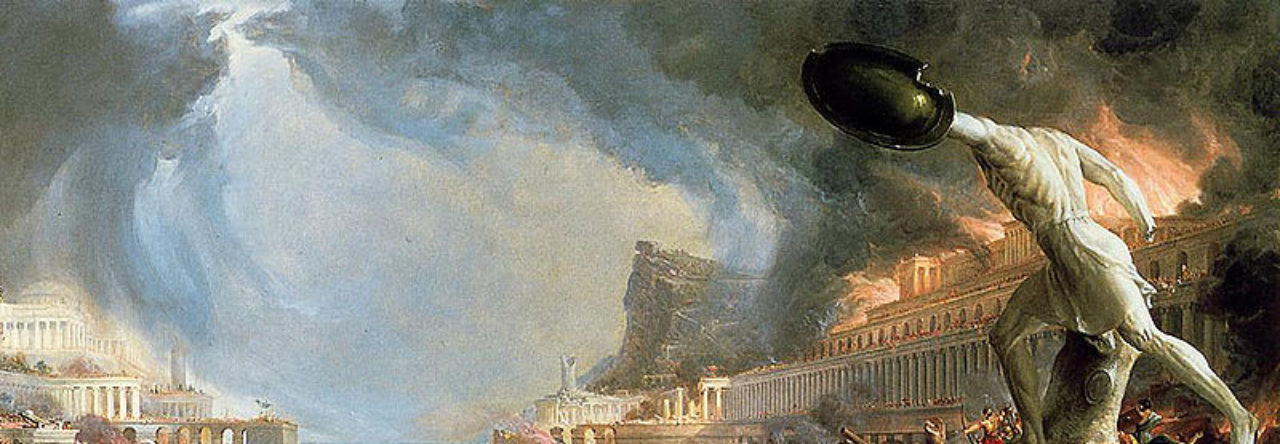 Wealth & Democracy is on of the ten most important books I have ever read, forming my understanding of the rise and fall of great manufacturing powers more than any other book. It’s a huge book, full of detail and covers a vast amount of material. Published in 2002, it covers American history up to 2000 AD, and has sections on the Spanish, Dutch, and English Empires. Each had a very similar trajectory in terms of manufacturing, wealth and financialization. Phillips is the best at explaining how financialization destroys Empires that I have read (and I’ve read plenty.)
Wealth & Democracy is on of the ten most important books I have ever read, forming my understanding of the rise and fall of great manufacturing powers more than any other book. It’s a huge book, full of detail and covers a vast amount of material. Published in 2002, it covers American history up to 2000 AD, and has sections on the Spanish, Dutch, and English Empires. Each had a very similar trajectory in terms of manufacturing, wealth and financialization. Phillips is the best at explaining how financialization destroys Empires that I have read (and I’ve read plenty.)
Because it’s so large, I’m going to review it in sections. The first section is a review of wealth in American from before 1776, to 2000.
Pre-revolutionary fortunes were fortunes of war and mercantile interests, but primarily war. Those who supplied the armies and navies in Britain’s North American campaign made bank, and so did privateers.
Revolutionary fortunes are also about selling war materials to the American military and about privateering. William Morris, in charge of procuring war goods, awarded a quarter of all contracts to… himself, for example. There were about 2,000 privateers and they captured about 3,000 British ships and their cargoes.
These profits formed the first great fortunes in America.
The next set came from buying up war bonds, often at cents on the dollar. There was a huge fight over whether those sold on the secondary market would be redeemed, but that fight was won by financiers, and the speculators became rich, indeed half appears to have gone, not to the original purchasers but to speculators. This largesse was paid for by excise taxes which hit the backcountry poor hard, and caused the Whiskey Rebellion, brutally put down.
Then from 76-1812 we see New England financial interests taking charge, led by men like Hamilton. They created the first national bank, the Bank of the United States and, strangely enough, the bank favored mercantile and financial elites, causing much complaint. Meanwhile the privateers often became pirates, to which a blind eye was turned, and there was also significant trade, in particular with Britain.
The point here, and it becomes tedious and expected as the book goes on, that who got to be rich was determined largely by government action.
The War of 1812 has similar effects. Lots of money from privateering, lots of money for those supplying the military (at usurious prices amid great self-dealing) and plenty of money for the financiers of the war. The stock market grows and inequality soars. This continues thru to the Civil War, which is the next big watershed.
You won’t be surprised that supplying the Union army turns out to have been very worthwhile and so was privateering and financing the war. After the war, the South is essentially sacked. Oh there’s the freeing of the slaves (which were most of the wealth), but vast wealth in other forms flow North, so much so that if the South had been considered a separate country paying a war indemnity, the amount would exceed that paid by France to Germany after losing the Franco-German war. Wealth and income concentrates further in the North, stock markets vastly expand and New York takes the definite lead as the financial capital from Boston and Philadelphia.
From about 1830 to 60 shipping and banking decline and the great fortunes are in real-estate, whether urban or rural.
To put some numbers to the decline of the south, from 1860 to 1870 agriculture and manufacturing capital declines 16%, while the north increases 50%. The war also super-charged manufacturing. Capital in manufacturing 1860 was about 10 billion. By 1900 it was 100 billion.
The great post-war fortunes are those of the railroads, manufacturing and various trusts like Standard Oil. The fortunes are VAST and the corruption is striking. The Senate becomes the most powerful branch of government, and the appointed Senators are widely known to be owned by various financial and industrial interests. The government massively subsidizes the railroads, in particular with vast land grants, they become the most important economic sector in the country. Effectively an oligopoly, and run as such, they are able to take oligopoly profits. After all, if you want your product shipped to market it’s the railways, or the railways. You can also choose the railways.
Money moves to gold, and the money supply contracts. There are decades of deflation and farmers in particular are squeezed badly. This leads to the rise of Prairie populism, with its battlecry of “silver money” and the famous image of the American people crucified on a “cross of gold.” But prairie populism is never able to win at the Federal level and by the opening of the 20th century capital is victorious almost everywhere, fortunes of the richest are vast and government is completely captured.
But, unlike our era, the fortunes are undergirded by real resources: railroads, vast new lands, huge amounts of manufacturing. By 1890 the US has overtaken Britain to become the world’s greatest manufacturing country.
We’ll pick up this extended review around 1900, because huge changes are coming. The populists failed, the progressives won’t.
***
If you’ve read this far, and you’ve read some of my articles and most if not all of Ian’s, then you might wish to Subscribe or donate. Ian has written over 3,500 posts, and the site, and Ian, need the money to keep the shop running. So please, consider it.

somecomputerguy
Embracing the gold standard, means embracing a structurally deflationary monetary policy-the economy grows, but the money supply doesn’t because it is based on a static source of value.
Farmers are paying back loans, not just with nominal interest charges, but with money that is more valuable than the money they borrowed.
They do that by selling crops that are now lower priced than when they were planted. That premium, of course accruing to lenders.
When Stalin did it to finance the U.S.S.R.s industrialization, it coined the term ‘forced savings’ (from agriculture).